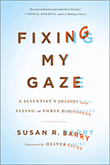Stereo-Blind: People who can't see 3D
Not everyone is loving the 3D craze. Depending on which expert you listen to, between 2 and 12 percent of all viewers are unable to appreciate video shown in 3D. There are two possible reasons for not being able to watch 3D movies or television:
- You are unable to see the 3D effect.
- You are able to see the 3D effect but it has unacceptable side-effects such as headaches and nausea.
If you are unable to see the 3D effect at all, you may be stereo-blind, otherwise referred to as having monocular vision, being a flat-viewer or lacking depth perception. The most common reasons for stereo-blindness are:
- Medical disorders that prevent the eyes focusing and/or aligning correctly (e.g. amblyopia, strabismus, optic nerve hypoplasia).
- Loss of vision in one eye.
If you are able to see the 3D effect but it causes you discomfort, you may have a mild binocular disorder.
If you aren't sure about your 3D vision, take our quick online depth perception test.
Note: A person who is able to see in full 3D is called stereo-acute.
How can stereo-blind people watch 3D videos?
Unfortunately for stereo-blind consumers, manufacturers have been largely silent about the implications for anyone left behind by 3D technology. They have however indicated that all TV sets should be backwards-compatible in some way.
If you're stereo-blind and you only ever intend watching movies alone, you'll be fine. You can watch television in 2D and see 2D films at the theatre (at least for the foreseeable future).
If you want to watch TV or go to a movie with other people who want to see 3D, it might be a little more difficult. The best approach may depend on your situation.
- If you only have sight in one eye, you'll probably end up wearing the glasses and just seeing one view. This will reduce the picture quality slightly but should be perfectly acceptable.
- If you can see the 3D effect but find it uncomfortable or irritating, your best hope is that manufacturers will find a way to show 2D and 3D versions simultaneously on the same screen, allowing each viewer to decide which version they watch. There is a good chance that this will happen—if discomfort affects a significant number of people then manufacturers will have no choice but to respond.
- You can purchase glasses that convert 3D movies back into 2D.

Can you learn to see in 3D?
Traditionally it was thought that depth perception could only be learnt in infancy, and that stereo-blind adults could never become stereo-acute. However this belief has changed and many optometrists now offer equipment and training to help people acquire true binocular vision. According to numerous reports and testimonials, people who never realised what they were missing have found a new way to view the world. An interesting example is related in the book Fixing My Gaze by neuroscientist Susan R. Barry, who gained stereoscopic vision at the age of 48.
Conclusion
The current generation of 3D video is still being developed and there's no need to worry just yet. 3D remains a long way from being the norm and stereo-blind consumers will probably be accommodated in some way if/when it does become the standard. The worst case scenario is probably that, for a while at least, you'll need to wear glasses just to see in 2D.
Of course this only applies to the current generation of 3D displays that require glasses. Eventually 3D displays that don't require glasses will become the standard, but we'll wait until then to see how that affects things.